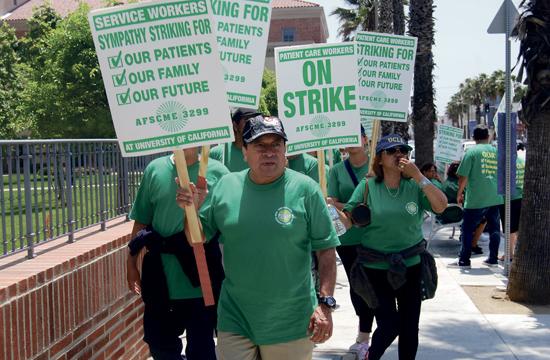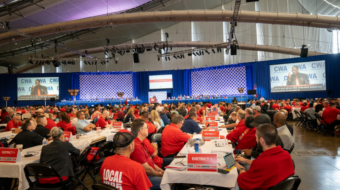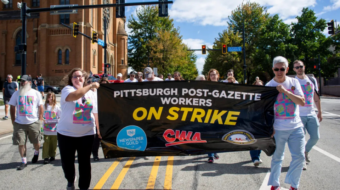
WASHINGTON – The federal government has opened a legally required review of a rule designed to cut or eliminate worker exposure to blood-borne illnesses – a rule that AFSCME and other unions thought they permanently won several years ago.
The Occupational Safety and Health Administration’s review of the blood-borne pathogen rule is one of several job safety regulatory actions the Obama administration plans in coming months, according to the semi-annual list of planned regulatory actions, released July 23.
The list is important, not only for its specific items that affect workers, but as at least a partial indication of where the government is headed, particularly in protecting workers and residents’ health and safety.
President Obama has made clear that since a dysfunctional Congress refuses to attack national problems – everything from climate change on down – he will use federal rules to do so. But in a sop to business to try to woo them before last year’s election, Obama also ordered agencies to review current rules.
The catch with Obama’s promise, veteran AFL-CIO Occupational Safety and Health Director Peg Seminario told Press Associates Union News Service, is that Labor Department agencies often send over to Obama’s White House Office of Management and Budget proposed rules to help workers – and watch them sink from sight there.
Indeed, OMB has sat on so much, she adds, that “this administration’s record on OSHA rules is worse than that of (George W.) Bush.”
Meanwhile, the business-backed Regulatory Flexibility Act forces OSHA to review an existing rule designed to cut down worker exposure to blood-borne pathogens in hospitals and other health care facilities.
Interestingly, Seminario adds, when the feds do the required reviews, the data disprove business’ dire predictions about the negative impact of federal rules.
“OSHA has always had to do this. They look around and ask questions. It gives them the opportunity to see what actually happened” when they required a business to follow a rule, as OSHA required health care facilities to cut worker exposure to blood-borne disease.
“And what OSHA finds is that businesses were able to comply with the rules, and that the rules were effective and they’ve worked,” she adds.
In the case of the blood-borne pathogens rule, OSHA “will consider the continued need for the rule, whether the rule overlaps, duplicates, or conflicts with other federal, state or local regulations, and the degree to which technology, economic conditions, or other factors may have changed since the rule was evaluated.” OSHA plans to end the review and release results in October. Other federal rulemaking proposals include:
- After a decade of prodding, pushing and hauling, OSHA says it will start work on a rule – officially called a Notice of Proposed Rulemaking – to cut worker exposure to crystalline silica, which causes chronic silicosis.
Right now, workers, especially construction and shipyard workers, can be exposed to 10 milligrams of silica per cubic meter of air yearly. OSHA says that limit is too high, based on outdated measuring methods and hasn’t changed since 1968. It wants to cut exposure to between 25 micrograms and 50 micrograms per cubic meter.
“The Building and Construction Trades Department of the AFL-CIO has also developed a recommended comprehensive program standard” for worker exposure to silica, OSHA says. “These standards include provisions for methods of compliance, exposure monitoring, training, and medical surveillance.”
- The 14-year campaign by the Steel Workers – and their Paper Workers members before that – to cut worker exposure to beryllium, which causes cancer, isn’t over yet. But almost three years after the agency ended taking comments during its scientific peer review of proposals to cut beryllium exposure, it will, in October, issue a notice that it plans to create a rule attacking the problem.
- In an agreement with the Steel Workers, OSHA will issue a rule in December about when construction contractors can confine their workers in small spaces – and how to protect them. There’s been a general industry standard for working in confined spaces on the books for 20 years, OSHA says.
“But this standard has not been extended to cover employees entering confined spaces while engaged in construction work because of unique characteristics of construction worksites,” OSHA explains. The Steel Workers campaigned for a stronger general industry standard and won. Protecting the construction workers for the first time, OSHA admits, is part of that settlement with the union.
- Electric power line workers have a high on-the-job death rate: 50 deaths per 100,000 workers annually. After a decade of work, OSHA plans to update its 40-year-old rule on how to protect them, and to regulate protective equipment too, with a final rule ready – it says – this month.
“OSHA has developed a revision…that will prevent many of these fatalities, add flexibility, and update and streamline the standard,” its statement says. “OSHA also intends to amend the corresponding standard for general industry so requirements for work performed during the maintenance of electric power transmission and distribution installations are the same as those for similar work in construction.
“In addition, OSHA will be revising a few miscellaneous general industry requirements primarily affecting electric transmission and distribution work, including provisions on electrical protective equipment and foot protection. This rulemaking also addresses fall protection in aerial lifts for work on power generation, transmission, and distribution installations,” the agency says.
- Until it gets more information, OSHA is delaying further action to curb worker exposure to diacetyl, a chemical used in creating butter flavorings for cookies and popcorn that causes fatal bronchitis in workers.
The Teamsters and the United Food and Commercial Workers asked OSHA six years ago for an emergency rule to stop diacetyl exposure, but the agency turned them down. It still intends to write a rule, its notice says, but it’s waiting for a report from the National Institutes of Occupational Safety and Health on the effects of diacetyl exposure – and the risk of it.
The years-long process to get a new rule on the books frustrates Seminario and others concerned with worker safety and health. “The regulatory agenda basically kicks the can down the road,” she comments. “We haven’t had any movement out of OMB. The silica rule hasn’t even been started yet. You need support from the White House to get anything.”
That backing from Obama isn’t there, she says. “We’ve been pushing and prodding and continue to do so,” she adds before making the Obama-Bush comparison. “It’s appalling, and I don’t know what the rank and file can do.”
The regulatory agenda also includes plans from independent agencies. But it does not include a proposal, floating around the National Labor Relations Board but not yet written down, to expand the data firms must legally turn over to unions for contact purposes during an election campaign, after the union files required authorization cards.
The data, in the so-called Excelsior list, now includes just names and addresses. The proposal would add telephone numbers, email addresses and work locations.
Photo: AFSCME has fought hard for higher safety stnadards for hospital workers (like those pictured, at Santa Monica-UCLA Medical Center in California) who are at risk from blood borne pathogens. Parimal M. Rohit/AFSCME 3299










